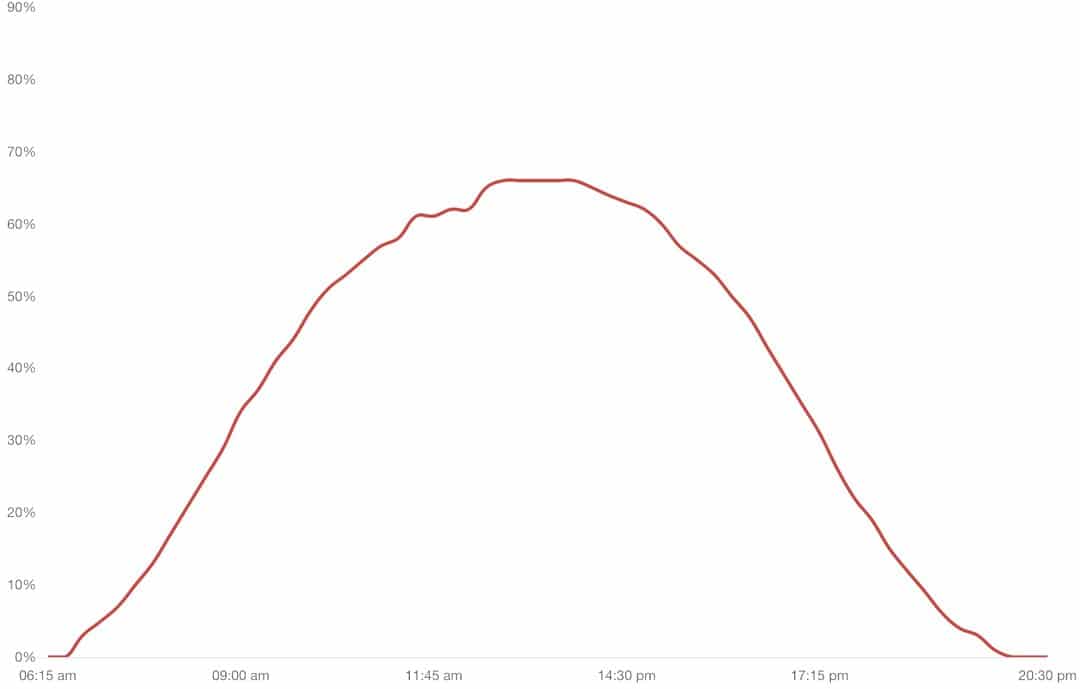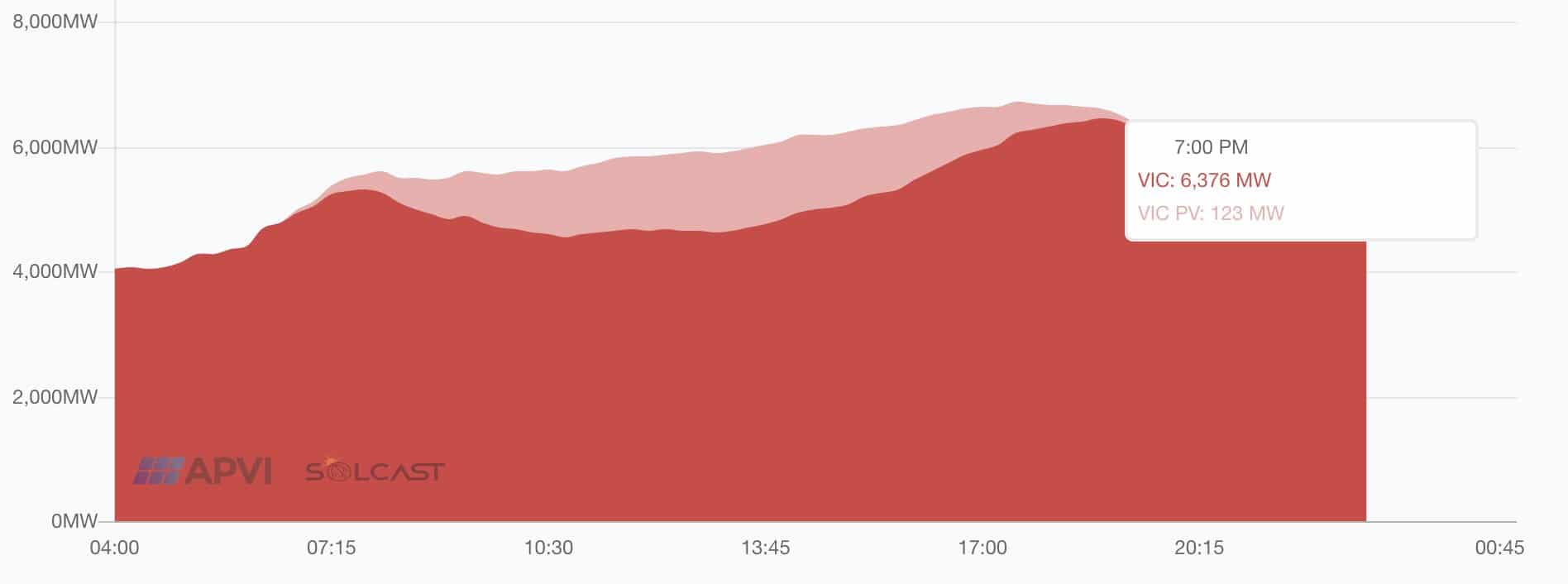Investor News
Wind and solar failing to keep costs down and lights on
With the increased penetration of wind and solar power and the unexpected closure of Hazelwood brown coal power station in March 2017 wholesale electricity prices have skyrocketed and the risk of blackouts have increased.
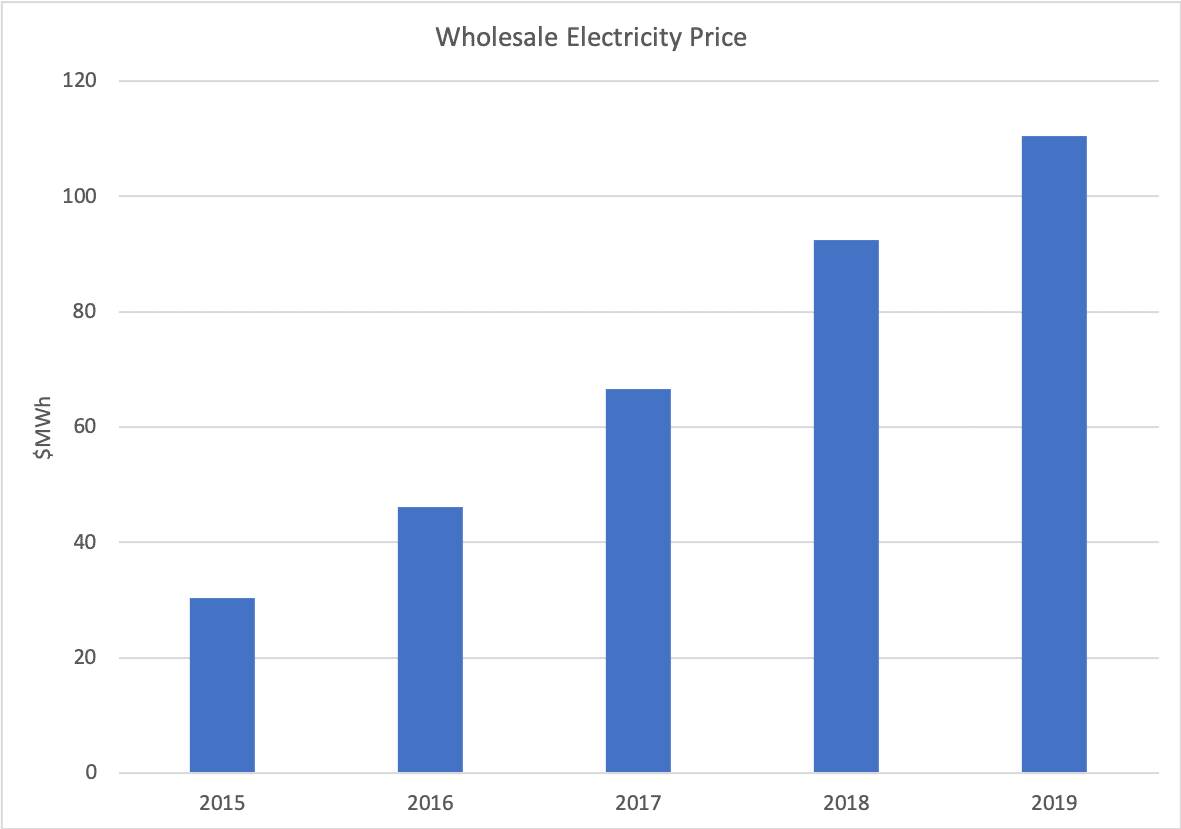
The following chart confirms the impact that unreliable energy sources are having on energy affordability.
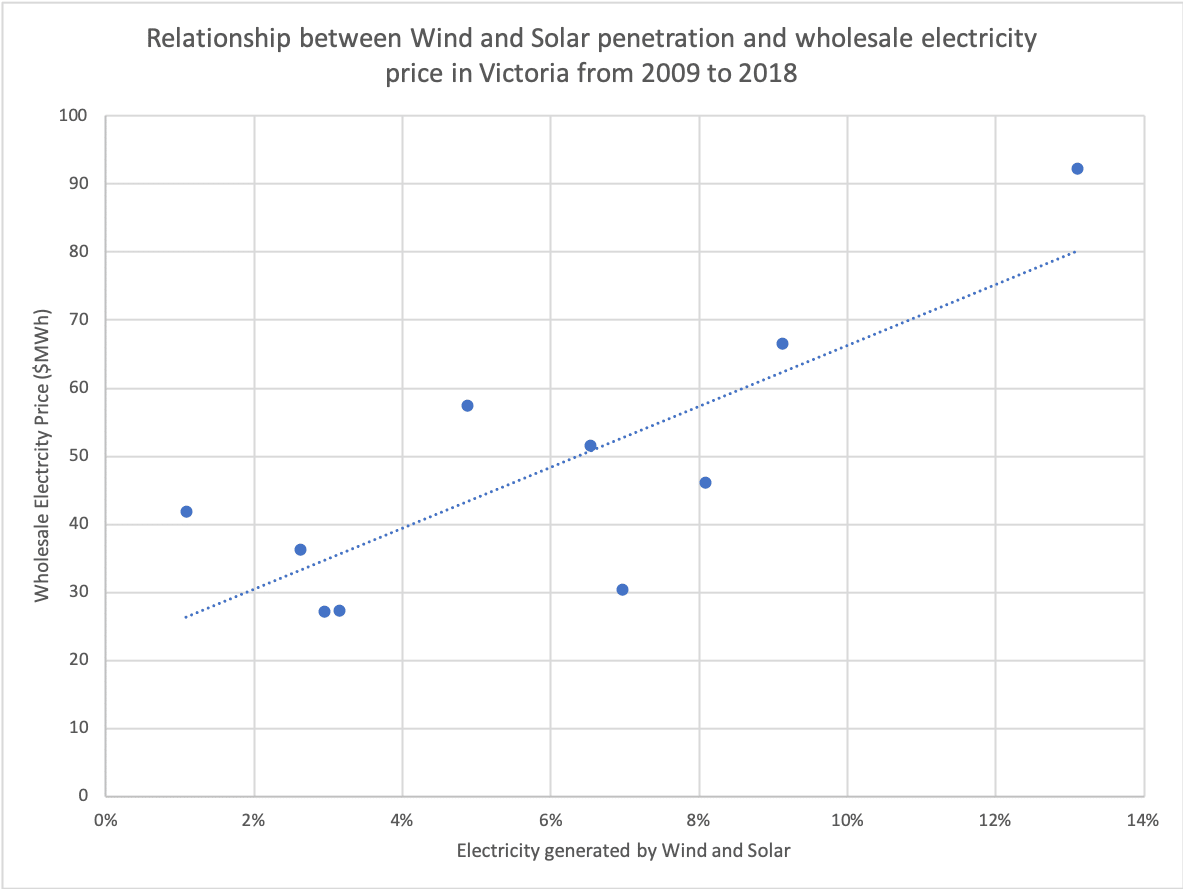
Today's article ($) in the Australian Financial Review (AFR) by Mark Ludlow and Angela Macdonald-Smith highlights the precarious position we face as the Australian Energy Market Operator (AEMO) scrambles to keep the lights on as we head into summer.
The article notes the influx of 3,700MW of new solar capacity across the NEM, then describes how AEMO may need to resort to paying large users up to $44 million to shut an additional 1500MW of demand, should the need arise, to keep the lights on.
This combined new solar rooftop capacity and 'demand' management total 5,200MW. This sounds impressive and seems like more than enough to fill the 1,600MW gap left by Hazelwood, however, the media often leaves out mention of the capacity factor of wind and solar, which is the important number.
That 3,700MW of new rooftop solar has a capacity factor of around 20% to 25%, delivering a useable 740MW to 925MW of output.
Unfortunately, peak output drops rapidly, as shown in the following chart.
Solar can't meet the demand curve without the addition of countless expensive batteries.
On a recent hot day in Victoria, rooftop solar met a paltry 4.6% of demand in the morning peak and 2.5% of the evening peak, compared to around 20% of demand in the middle of the day, for about an hour.
In addition, Victoria has deployed around 580MW of wind capacity since the closure of Hazelwood in March 2017. But again, the capacity factor is only 30% and can vary suddenly from 100% to 0%, requiring a fleet of gas-fired power stations or hydropower to compensate for the unreliability.
As wind and solar penetration increase, costs increase and reliability decrease, threatening economic and energy security.
Despite this clear trend, governments are doubling down on wind and solar.
The intent - to save the world from global warming - is honourable, but the policies are adding cost and reducing energy security without any sign of environmental benefit.
Back in 2007 Google embarked on a huge project called RE<C (renewable energy cheaper than coal).
At the start of RE<C, the engineers shared the attitude of many environmentalists: that with steady improvements to today’s renewable energy technologies, society could stave off catastrophic climate change.
By 2011 it was clear they could not develop a technology that could compete with coal and declared the notion unviable.
They came to the conclusion that even if Google and others had led the way toward a wholesale adoption of renewable energy, that switch would not have resulted in significant reductions of carbon dioxide emissions. Trying to combat global warming exclusively with today’s renewable energy technologies simply won’t work; a fundamentally different approach was needed.
Among many lessons, three stood out:
- Electricity needs to be generated at a cost of between $40 and $60 per MWh
- Dispatchable power has more value than intermittent power (wind and solar)
- Change needs to come via investment in innovation
Economically regressive subsidies for wind and solar are an inefficient allocation of scarce resources and are relatively useless in terms of taking effective action on global warming, given the fully implemented Paris Climate Agreement would only reduce the projected temperature in 2100 by 0.17 degrees celsius according to this peer-reviewed study.
AEMO buys up record energy reserves for long, hot summer
DECEMBER 04, 2019 | AFR | Mark Ludlow and Angela Macdonald-Smith
Fears of a long, hot summer causing large-scale blackouts have forced the Australian Energy Market Operator to lock in a record 1600 megawatts of emergency reserves to help the electricity grid survive the next three months.
Source ($): https://www.afr.com/companies/energy/aemo-buys-up-record-energy-reserves-for-long-hot-summer-20191203-p53gd3
Article Overview
Prepared for summer
The AEMO summer readiness report to be released on Wednesday said they were preparing for a hot summer with higher than average temperatures which can increase the likelihood of generator failures.
They said there was a 10 per cent chance of exceeding the maximum demand forecast for this summer.
AEMO said despite 3700 megawatts of additional capacity coming into the grid since last summer – the bulk of which was roof-top and large-scale solar – there was still a possible shortfall of 125 megawatts in Victoria this summer.
AEMO has secured the 125 megawatts through off-market generation, along with demand management programs where customers are paid to shift or reduce their energy usage.
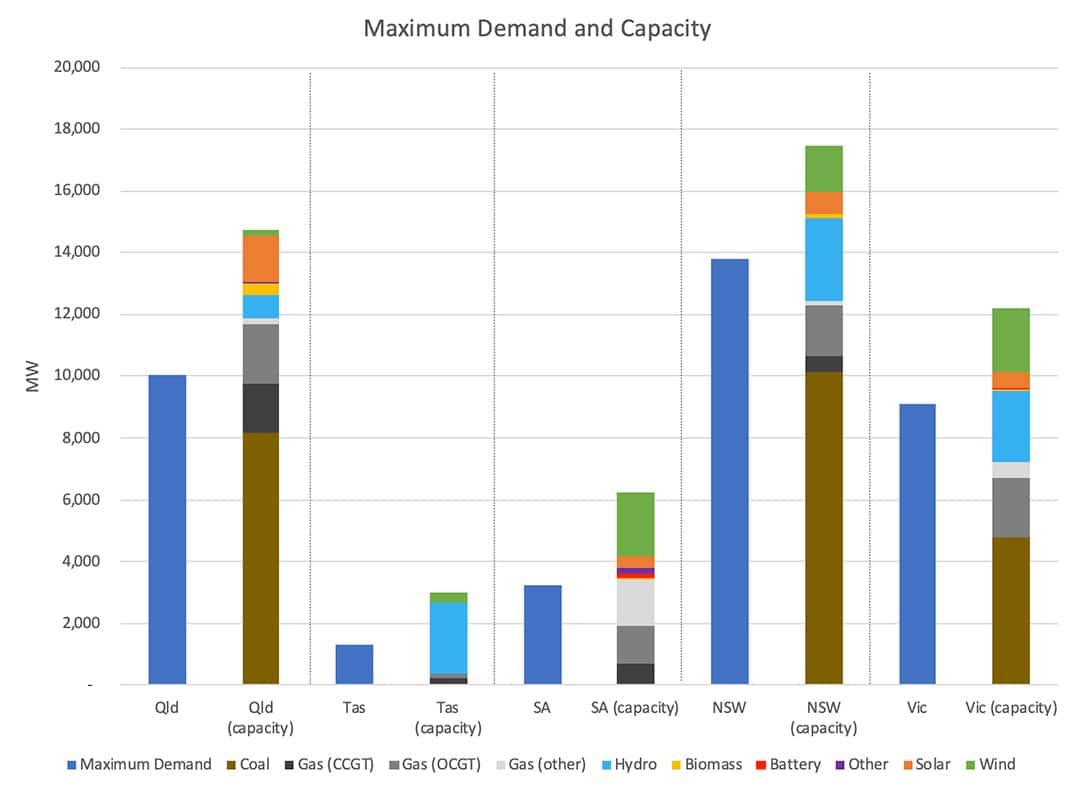
The reserves include 61 megawatts of long notice Reliability and Emergency Reserve Trader (RERT) contracts and 64 megawatts through the joint AEMO/Australian Renewable Energy Agency demand-side participation trial.
But in a move which suggests how worried the market operator is about load-shedding or blackouts this summer, AEMO has entered into more than 1500 megawatts of short and medium-term notice RERT agreements across the National Electricity Market
This will allow them to quickly enter into more reserve contracts, if required.
More than 1000 megawatts is available for Victoria and South Australia – the two states identified as trouble zones for the summer – with the remainder in NSW and Queensland to cover risks associated with "extreme system scenarios".
Last summer, AEMO paid $34.5 million to secure about 1000 megawatts of reserves. It predicts it will cost about $44 million this summer and the first month of autumn (March).
In previous summers, AEMO has called on big industrial users such as smelters to cut production when it looked like large blackouts were looming.
Tomago aluminium smelter near Newcastle performed this function in 2017 – when it shut down its potlines for an hour – but it was not compensated for the loss of production.
AEMO is now trying to formalise the agreement with big smelters, including Tomago and Alcoa's Portland Smelter in Victoria.
Tomago chief executive Matt Howell would not comment on whether they had signed a RERT contract for this summer, but he said energy-intensive smelters could help by taking load off the grid at short notice.
"We recognise the value an operational smelter can bring to grid stability because they can take a big load off at short notice," Mr Howell told The Australian Financial Review.
"But because of the cost of the lost production we are looking to monetise this process."
Potential shortfall
AEMO is also worried the potential energy shortfall could be exacerbated if there was any delay in the return to service of Loy Yang A and Mortlake power stations in Victoria which are currently out of action.
Origin Energy earlier this week reported an expected 10-day delay in restarting its Mortlake gas-fired power station in Victoria, which won't be online until December 30.
AGL Energy has meanwhile confirmed that the unit that has been out of action at its Loy Yang A coal power generator in the Latrobe Valley will be back online as scheduled in mid-December.
In addition to the repairs to Loy Yang A, AGL has spent $150 million across its key generation sites at Macquarie in the Hunter Valley, Loy Yang and Torrens in South Australia to improve the readiness of its power station fleet to meet peak summer demand, according to the company's executive general manager group operations Doug Jackson.
It also has brought online new gas power capacity in South Australia at its $295 million Barker Inlet plant which can be fired up to full capacity in just five minutes.
The worries about supply scarcity over the summer is clearly visible in forward prices for wholesale electricity in the March quarter of 2020, where prices in Victoria are standing at $135 a megawatt-hour, 80 per cent above prices for this quarter.
Still, prices fell in November across the market and have fallen further this week, with JPMorgan suggesting that lower gas prices and greater competition in gas supply could be helping.
Energy suppliers and users are still worried that any power cuts will lead to kneejerk reactions by policymakers that in the end will cost consumers more and called for “cool heads” to prevail in managing the power system over the summer.
The groups, including Australian Industry Group and the Energy Users Association of Australia urged consumers to help minimise the cost of using back-up power reserves by not running non-critical equipment on very hot days.
"If the lights do go out this summer, we must avoid another round of the blame game and point-scoring that so often distracts us," the groups said.
